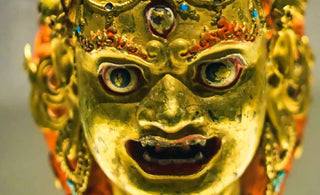
In the dynamic landscape of contemporary Tibetan Buddha statues, a notable trend emerges—the power of personal narratives woven into the sculpted fabric of divinity. These modern interpretations transcend traditional representations, inviting artists to infuse their work with individual stories, struggles, and triumphs. The resulting statues become not only embodiments of timeless spiritual teachings but also vessels that carry the personal narratives of the artists who breathe life into them.
One exemplary manifestation of this trend is the statue titled "Journey of Self-Discovery: A Contemporary Interpretation." In this artwork, the artist integrates personal experiences and reflections into the depiction of Buddha Shakyamuni. The facial expression, typically serene, now reflects the artist's own journey of self-discovery: a nuanced blend of tranquility, resilience, and the wisdom gained through personal trials. The statue becomes a mirror reflecting not only the timeless teachings of the Buddha but also the unique narrative of the artist's spiritual evolution.
The landscape of contemporary Tibetan Buddha statues is further enriched by artists who draw inspiration from their cultural heritage and personal encounters. "Whispers of the Himalayas: A Sculptor's Journey" is an exemplary piece that embodies this fusion. The artist, drawing from personal visits to the Himalayas, sculpts a Buddha figure surrounded by symbolic elements inspired by the region.
The sculpture features a Buddha figure, serene yet resonant with a palpable energy that transcends the traditional portrayal of divinity. Every aspect of the artwork, from the flowing texture of the robes to the carefully chosen motifs, serves as a brushstroke in the canvas of the sculptor's personal journey. The robes, reflecting the artisan's hands, speak not only of craftsmanship but also of a tactile connection with the very materials that shape the narrative.
The Himalayan landscape, with its towering peaks, dense forests, and flowing rivers, becomes an integral part of the sculpture's symbolism. The artist skillfully incorporates these elements, each a silent witness to the sculptor's encounters and revelations during travels. The choice of motifs, whether inspired by indigenous flora, fauna, or sacred symbols, narrates a story of profound connection with the cultural tapestry of the Himalayas.
The texture of the robes becomes a tactile testimony to the sculptor's exploration of diverse materials—a conscious choice to breathe life into inert substances. The artist's hands, guided by the wisdom gleaned from the Himalayan sojourns, sculpt not just a static figure but a living embodiment of personal discovery and spiritual resonance.
Through the strategic placement of symbolic elements, the sculptor invites viewers to partake in the journey. Perhaps a prayer wheel echoes the rhythm of mantras whispered in the high mountain monasteries, or a lotus blossom emerges as a symbol of enlightenment amidst the rugged Himalayan terrain. Each detail serves as an invitation, a beckoning to explore the nuanced layers of the artist's experiences and insights.
The meticulous craftsmanship in "Whispers of the Himalayas" goes beyond the realm of technique; it becomes a form of meditation, a contemplative process through which the artist channels the essence of the Himalayas into tangible form. The artist's encounters with the region's people, their stories, and the palpable spirituality of the landscape all find expression in the statue's features. Each detail, from the texture of the robes to the choice of motifs, narrates a personal journey of connection with the cultural and spiritual richness of the Himalayan landscape.
These personal narratives embedded in contemporary Tibetan Buddha statues open a dialogue between the sacred and the individual, transcending the boundaries of traditional representation. "Echoes of Enlightenment: The Artist's Inner Journey" is an evocative piece that delves into the artist's introspective exploration of enlightenment. Through intricate details and symbolic gestures, the statue becomes a canvas for the artist's inner journey—a visual diary that transcends the confines of words.
The power of interpretation extends beyond the sculptor's chisel, involving the viewers as active participants in the narrative. "Contemplation Unveiled: An Interactive Encounter" is a groundbreaking piece that incorporates interactive elements, allowing viewers to physically engage with the statue. This fusion of art and interaction transforms the viewing experience into a personal contemplation, where individuals bring their own stories and reflections into the sacred space of the artwork.
As we navigate the rich tapestry of contemporary Tibetan Buddha statues, the power of personal narratives becomes a beacon guiding us through a diverse landscape of spiritual expressions. These statues cease to be static representations and evolve into dynamic storytellers, inviting us to explore the intersection between the universal teachings of Buddhism and the unique narratives of those who shape these divine forms.
Conclusion
In conclusion, the infusion of personal narratives into contemporary Tibetan Buddha statues represents a profound shift in the way we engage with sacred art. Each statue becomes a testament to the artist's journey, a mirror reflecting the complexities of personal experiences, and an invitation for viewers to embark on their own contemplative voyages. The evolving landscape of interpretation in these statues not only honors the timeless wisdom of Tibetan Buddhism but also celebrates the richness of individual narratives that contribute to the ever-expanding tapestry of spiritual expression.























